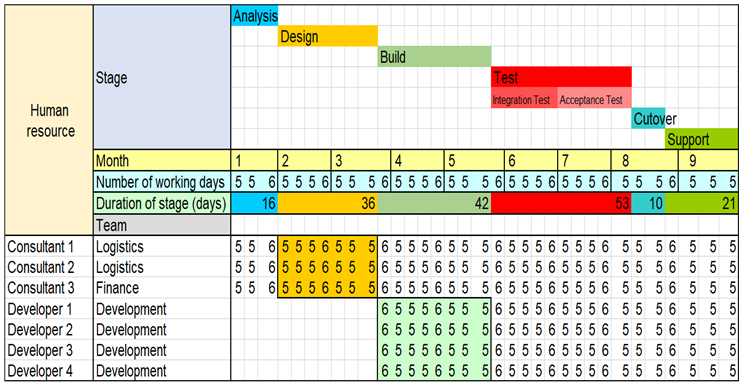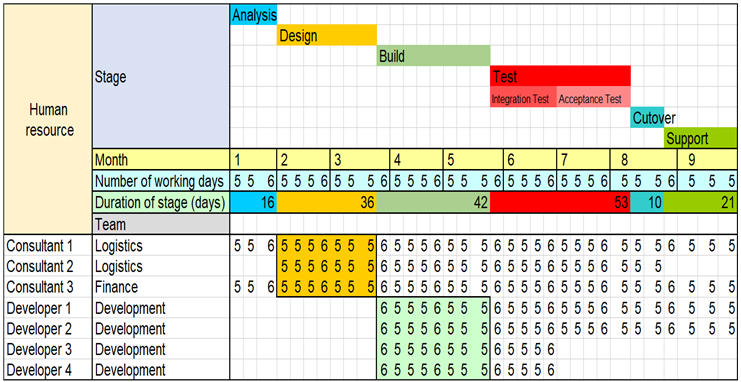Novel planning technique for ERP-systems implementation projects
- Подробности
- Опубликовано: 16.07.2022 16:54
- Автор: Степанов Дмитрий Юрьевич
- Просмотров: 8764

Abstract: the article is devoted to the proposal of a new way to build a resource plan for ERP-system implementation projects, which has ease of use and speed of obtaining results, and this in turn allows you to flexibly emulate various situations. The method is applicable to corporate system implementation projects in which the software development is carried out. The proposed method uses the mechanism of the RICEF estimator, which is an expert assessment of the labor costs for preparing and developing programs for a pair of parameters «type of development – complexity». In the future, benchmarking is used, which determines the duration of the project phases in percentage terms. Based on the calculated efforts that define the stages of design and build, and the results of benchmarking, the timing of all remaining phases is calculated. The distribution of labor costs for the remaining stages of the project is carried out according to the pyramid principle, for which milestones of the analysis, integration testing and cutover are processed. The final plan of human resources is based on the calculated labor costs set for all stages of the project. Consequently, creation of the project schedule, determination of the scope of work for all phases, as well as finalization of the resource plan are carried out using only the planned labor costs of design and build stages.
Download: PDF.
Keywords: implementation projects, project management, resource plan, PMBoK, RICEF classification, Fit/Gap-analysis, RICEF estimator, development lifecycle, ERP-systems implementation, Agile planning, phases of the project.
1. Introduction
Having decided to link your life with a career as a consultant of corporate information systems implementation (hereinafter – ERP systems) [1], it does not matter American, German or Russian production, there may be a mistaken feeling that you should certainly be able to program and only your technical skills play a role. This is not quite true. The beginning of corporate information system implementation projects, which seems to be a very non-trivial task, is always preceded by a fairly large number of work, which is indirectly related to technology [2]. From the project management point of view, the beginning of the ERP-system implementation is almost final and fairly predictable activity. The stages of analysis, design, build, testing, cutover, as well as post go-live support are typical of the project of implementing corporate systems (Fig. 1). Usually, the analysis stage is preceded by the activity of creating a technical task justifying the feasibility of implementing an ERP-system, as well as the key requirements for it, which beginners may not know due to lack of experience [3]. Next, technical and commercial proposals are formed, which describe what stages the project will consist of, the duration of the stages, the amount of necessary human resources, as well as how the requirements will be covered [4]. The contract for the implementation of an ERP-system is concluded only in case of successful sales, followed by just those six stages of the project that we have described above.
Fig. 1. Typical six stages of corporate information system implementation projects
2. Problem Statement
Building a resource plan is an important issue in the preparation of technical and commercial proposals, it determines the necessary amount of human resources for the project. Project timeline, the amount of human resources, as well as the composition of the expected work are closely related, which can be set by the following simplified formula:
Project duration = Total efforts / Number of human resources. (1)
The preparation of resource plan should be carried out in accordance with the content of the project, since changing the content will lead to an adjustment of the duration, which is easy to see in (1). A natural question arises, how to build a resource plan? The project management body of knowledge (hereinafter – PMBoK) talks about critical path and chain methods that allow you to build a logical structure of the work performed, set their duration, assign human resources for tasks and fix time buffers [5]. PMBoK describes project work «from the bottom up», that is, the final value is the sum of many individual subtasks. The necessary amount of resources is determined by calculation of the duration and scope of work in (1), after which they are aligned and smoothed in accordance with the stages of the project. Both methods are time-consuming and, of course, not flexible, but do not require deep technical knowledge. The created project plan is not of great value, the value lies in its daily adaptation to the prevailing realities, it is idea that can be found in the work [6], devoted to Agile planning. Really, the method should perform calculations quickly in order to provide modeling of a variety of possible situations, one cannot disagree with it. In practice, the application of the methods described both in [5] and in other literary sources similar in content [7-9], which provide a general understanding of building a resource plan, is very laborious and problematic. The purpose of this paper is to propose a faster way of building a resource plan for ERP projects. Achieving the goal requires consideration of the following tasks:
- overview of ways to evaluate efforts for program development;
- analysis of the duration of stages for ERP-system implementation projects;
- quick creation of a resource plan for ERP projects.
3. Evaluation of Development Efforts
From the formula (1) it is easy to conclude that finding the number of human resources requires determining the timeline of the project and the amount of work performed. Let's rephrase: it means building a resource plan requires calculating the duration, as well as the labor costs of each stage of the project. Usually, the customer provides a potential contractor with a technical task even before the start of the ERP-system implementation project, which specifies a list of the user's initial requirements for the future information system. Each of the requirements is analyzed by the contractor's experts to be classified as Fit or Gap [10-11], which is a mandatory step for preparing a preliminary ERP project plan. The requirements from the Fit area are considered already implemented by default in the basic package of ERP-system and do not require additional efforts, on the contrary, the Gap area serves as a signal about the need to refine or configure the information system (Fig. 2).
Fig. 2. Fit/Gap-analysis schema
The type of development and complexity are determined for each Gap requirement. RICEF classification is used for it, where R is report, I – interface, C – dataprocessing program (i.e. convention), E – anextension of the standard functionality of ERP-system (i.e. enhancement) and F – printedform. The complexity of the development is characterized by such values as: low, medium, high, very high [12]. The matching of the two parameters «type of development – complexity» is performed for each Gap requirement. The contractor's company has efforts determined by experts, necessary for the preparation of project documentation and the development of a program for all possible values of these pairs. Thus, RICEF estimator (Fig. 3) is a matrix linking the type of development and its complexity, as well as the planned efforts to prepare technical documentation and software development.
Fig. 3. Fragment of a RICEF estimator
4. Benchmarking of the Stage Durations
Stages allow you to group the same type of project tasks into a logical sequence of work. In fact, the stages of corporate systems implementation are a set of phases inherited from the software development lifecycle, from which the stages of idea and termination are excluded. The content, quantity, and the name of the phases strongly depend on the type of ERP project, in particular, they are distinguished:
- implementation «from the scratch», including pilot projects;
- rollout;
- development.
If we summarize the knowledge in the field of ERP-systems implementation, then the typical stages, regardless of the project, will be those given in Fig. 1. Of course, the specifics of projects dictate their own features, for example, pilot projects often include a pilot operation stage, but this does not significantly change the course of the project, so the typical six stages remain virtually unchanged.
Literature sources devoted to ERP projects [1-4], unfortunately, give only a general estimate of the duration of such projects. The implementation of ERP-systems from one year or more is considered the norm, but it is problematic to find more detailed information on the duration of each phase. Therefore, as statistical information, we will use the Russian projects mentioned in [13-14]. And based on them, we will try to formulate the recommended duration of the stages. This information is very important to us, without it we will not be able to build a human resource plan.
The RICEF estimator provides the calculation of efforts at the design and build stages. However, the duration of these two stages remains unknown. Let's take a closer look at all stages of ERP-system implementation projects. Statistics show that the sum of the design and build stages is at least 50% of the duration of the entire ERP project. Post go-live support stage is not included in the evaluation, since its duration is a constant agreed with the customer. Then it is possible to calculate the duration of all stages of the project in percentage terms using proposed benchmarking mechanism (Fig. 4).
Fig. 4. Benchmarking of the stage durations for ERP-system implementation projects in percentage terms, as well as the approximate duration of the phases for a typical case
So, the duration of the design and build stages is half of the project, and their percentage also varies. Usually the build stage lasts at least one and a half times longer than the design stage. The durations of the design and testing stages are comparable. The cutover stage is the shortest. Thus, you can find out the duration of the entire project by calculating the duration of at least one of the stages. The existing efforts for the preparation of project documentation and the development of programs calculated upon RICEF estimator will help us in this.
5. Building a Resource Plan
And now we will propose an algorithm for building a resource plan, knowing the efforts, as well as the preliminary duration of the stages of the ERP project. In our example, we will use the labor costs of the design and build stages, calculated based on the RICEF estimator, equal to 113 and 163 man-days, respectively. Then the procedure for building a resource plan will be as follows:
- it is required to set the initial duration of the design stage, considering the data in Fig. 4;
- then we impose the efforts of functional consultants found by RICEF estimator on the calendar grid. If the amount of labor costs exceeds the duration of the phase, you should add an additional human resource.The duration of the design stage and overall efforts of the functional consultants should coincide or differ by a minimum amount. Since calculation of the number of resources depends on the duration of the stage, we are guided by the rule that this number should be minimal. If it is not possible to select multiple resources, it is allowed to change the initial duration of the phase in greater or lesser directions.Selecting the optimal ratio of the phase duration and resource allocation, we find their final values;
- found duration of the design stage, equal in our example to 36 working days, allows us to find the duration of the entire project using a percentage of the benchmarking results (Fig. 4);
- we determine the number of developers, the same procedure is used as described in step 2, with the only exception that timing of the build stage has already been found on step 3;
- we will distribute the found number of consultants and developers to the remaining stages of the project, but exclude the analysis stage for developers, since they are not involved in it. We get a preliminary resource plan containing the total amount of effort in 1038 man-days (Fig. 5A).
Using the proposed procedure, we were able to build a resource plan for the corporate system implementation projects from the start date of the project. In this case, there is no limitation on the duration of the project. If the customer explicitly fixes the start and end dates of the project, the proposed scheme is also working, but you will need to reduce the duration of the design phase already at the 1ststep. After calculating the duration of all phases of the project, i.e. the duration of the entire project, it is compared with the start and end dates set by the customer. If necessary, the procedure is repeated many times, until the values of the phase durations satisfying the requirements are found. It is important to emphasize that the shorter project timeline, the more resources will be involved. The latter generates more likely risks of failure compared to a project of longer duration, but with less involvement of human resources.
The example of the plan in Fig. 5A seems redundant, in particular: the participation of not all functional consultants and developers is necessary at all stages of the project.
There is a hypothesis saying that the maximum amount of resources is required at the most critical stages of the project. In some literary sources [10, 15], this statement is called the pyramid principle. For us, these are the design, build and testing phases. Then we are able to propose the formula (2):
Number of resources at current stage = RoundToInt (Number of resources at previous or subsequent stage / 2), (2)
which will reduce the number of people in functional groups, considering the number of resources involved in the previous or subsequent stages. The assessment is empirical in nature, based on such project activities as: analysis, integration testing and technical cutover.
We can apply (2) and clarify the number of
- consultant resources at the analysis stage regarding the design phase;
- consultants at post go-live support stage regarding the cutover phase;
and
- developers in the acceptance testing, cutover, and post go-live support phases regarding to the build stage.
Fig. 5. Example of the human resources: a) preliminary redundant plan; b) final shortened plan
As a result, the volume of labor costs decreased by 15% and amounted to 887 man-days (Fig. 5B). Thus, it was possible to significantly reduce the involvement of team members in the ERP-system implementation project. The resource plan is based on a number of assumptions, in particular: ideal man-days are used to calculate the efforts, qualified personnel are considered, and projects of the corporate information systems implementation are processed, requiring only the development. Ideal man-days imply a situation where a person spends 100% of his time working without being distracted by any other tasks. According to [16], the best indicator of person employment is 70% of the working time, for example, at Toyota, at all other enterprises this indicator is noticeably worse. The amount of resources in the plan depends on the qualifications of employees, so the calculation is mainly carried out for human resources with more than five years of experience. In the case of using resources with lower qualifications, a recalculation of the plan will be required, which will lead to its increase. The resource plan is formed on the basis of two parameters: the scope of design and development work, which is its current limitation. However, in real projects, the number of tasks is much larger, for example, if we follow the theory of corporate systems [17], then a typical project has more than eleven groups of tasks.
6. Conclusions
So, what was the reason for writing this article? The analysis of literary sources [5-6] showed that at the moment there is no universal method for quickly creating a resource plan in projects for the implementation of corporate information systems. The available methods based on the critical path and chain oblige us to choose the duration of each task already at the initial stages of building a resource plan, which is incorrect, since the duration of the project is the value that we must find in the end. According to the author, the creation of a resource plan is reduced to the construction of a project schedule, in which the calculation of the stage durations and the resources involved is represented by two completely different, but interdependent tasks. The number of human resources affects the timing of the project and, conversely, the timing should be set based on the number of resources. The solution of this dual problem is the basis of the method proposed by the author.
The article proposes a method for quick creation of a resource plan for ERP-system implementation projects, for which the planned labor costs for the preparation of documentation at the design stage, as well as the development of programs at the build stage are used as input parameters. Labor costs at the design and build stages are determined using the RICEF estimator, while benchmarking allows you to determine the duration of all remaining stages of the project, knowing the timing of the design phase. Thus, the method is two-parametric. The proposed method ensures the creation of a human resources plan from the start date of the project. To form a plan from the end date of the project, it is necessary to shorten the duration of the design stage and increase the number of its human resources. At the same time, it should be taken into account that the shorter duration of the phase, the higher risks of non-fulfillment of tasks, regardless of the increase in the number of resources [18].
Fig. 6. Parameters determining the content of ERP-system implementation projects according to the theory of corporate information systems
Further development of the method consists in refining and automating the algorithm for reducing resources (2), as well as including actions not related to design and build in the scope of calculation. In the first case, you can apply the concept of entropy from information theory [19], in the second, you should use the theory of corporate information systems [17], which will determine an additional set of parameters responsible for the content of the project, namely: data migration, business cutover, roles and authorization, as well as change management (Fig. 6). Other parameters shown in Fig. 6, have already been included in the two-parameters method. The use of extra parameters will make it possible to transform the method of constructing a resource plan into a more complex algorithm, in which a larger number of project tasks will be taken into consideration.
References
- Habadi, A.: An Introduction to ERP-systems: architecture, implementation and impacts. International journal of computer applications 167 (9), 1-4 (2017).
- Stepanov, D.Yu.: Analysis, design and development of corporate information systems: theory and practices. Russian technological journal 8(3), 227-238 (2015). (in Russian).
- Ostroukh, A.V., Surkova, N.E.: Information system design. Publisher “Lan” (2019). (in Russian).
- Shirenbek, H., Lister, M., Kirmse, Sh.: A Guide to the project management body of knowledge: sixth edition. Publisher “PMI”, (2017).
- Cohn, M.: Agile estimating and planning. Publisher “Pearson”, (2005).
- Polkovnikov, A.V., Dubovik, M.F.: Project management. Full course MBA. Olymp-business (2018). (in Rus-sian).
- Heldman, K.: Project management jumpstart. Sybex, (2018).
- Tsiteladze, D.D.: Project management. Publisher “Infra-M”, (2022). (in Russian).
- Gvozdeva, T.V., Ballod, B.А.: Information systems design. Publisher “Phoenix”, (2009). (in Russian).
- Ali, M., Miller, L.: ERP system implementation at large enterprises – a systematic literature review. Journal of enterprise information management 30(1), 666-692 (2017).
- Stepanov, D.Yu.: Preparing functional specification documents for corporate information system develop-ment on SAP ERP example (part 1). Corporate information systems 3(7), 29-52 (2019). (in Russian).
- Kalyanov, G.: Consulting: from business strategy to corporate information system, Publisher “Goryachya tele-com line”, (2011). (in Russian).
- Stepanov, D.Yu.: Using Agile methodology in ERP-system implementation projects. Proceedings of the 35th International Conference on Information Technologies (InfoTech-2021), pp. 1-4 (2021).
- Sudakov, V.A.: Corporate information systems. Publisher “MAI”, (2016). (in Russian).
- Blokdyk, G.: ERP and Agile methodologies: a complete guide. Publisher “5STARCooks”, (2020).
- Stepanov, D.Yu.: The theory of corporate information systems. Proceedings of International Russian automa-tion conference (2022). (in press).
- Laudon, J., Laudon, K.: Management information systems. Prentice hall, (2002).
- Mackay, D.: Information theory, inference and learning algorithms. Cambridge university press, (2003).
Paper details
Dmitry Yu. Stepanov. Novel planning technique for ERP-systems implementation projects // Communications in Computer and Information Science, Springer, Cham. 2022. vol. 1733, pp.115-124. https://doi.org/10.1007/978-3-031-23744-7_9. – URL: https://stepanovd.com/science/article/143-2022-2-planningtechnique.











